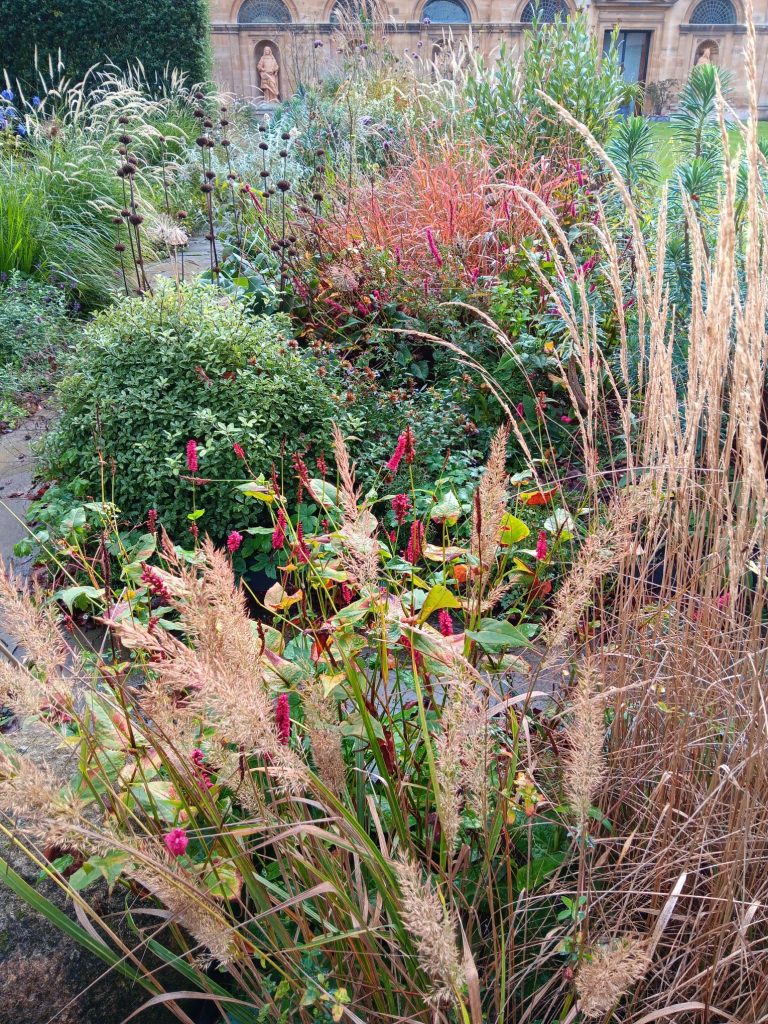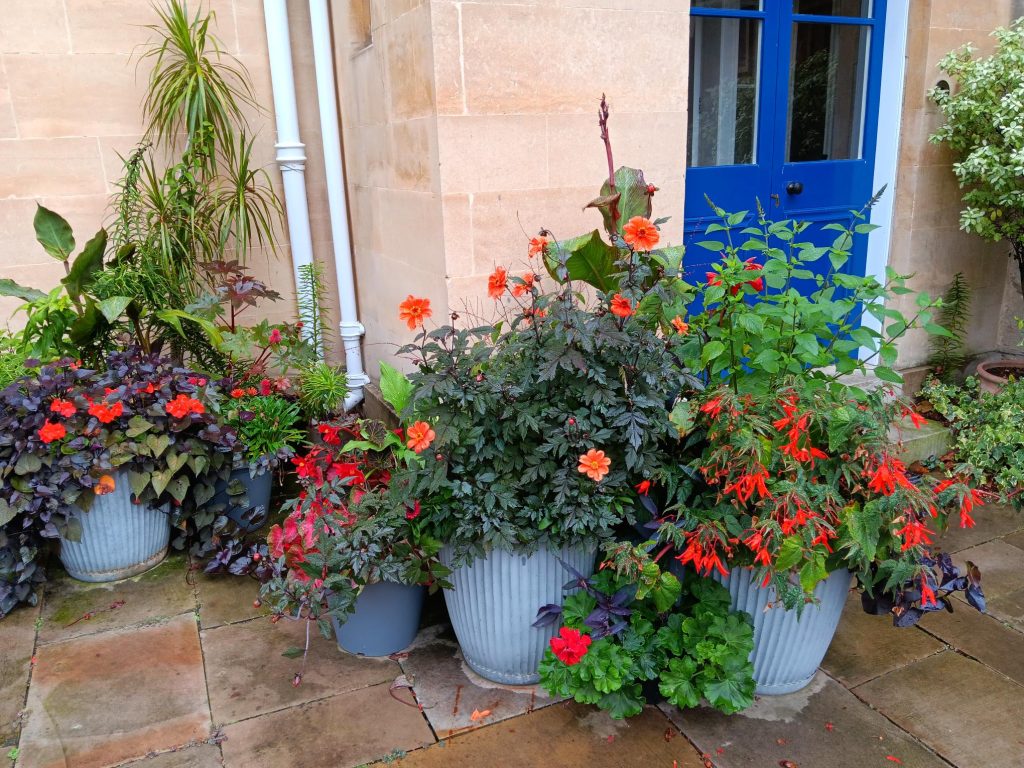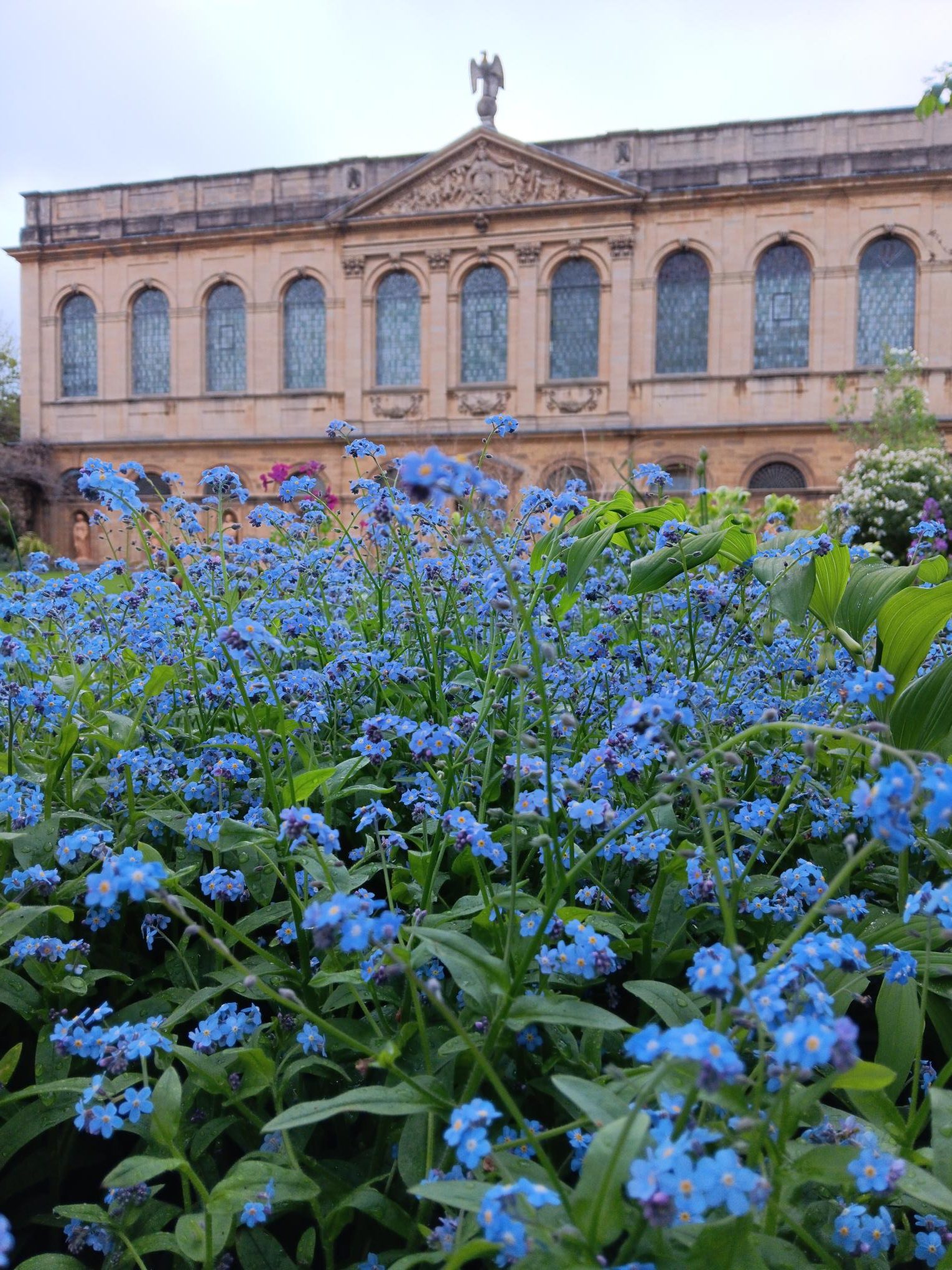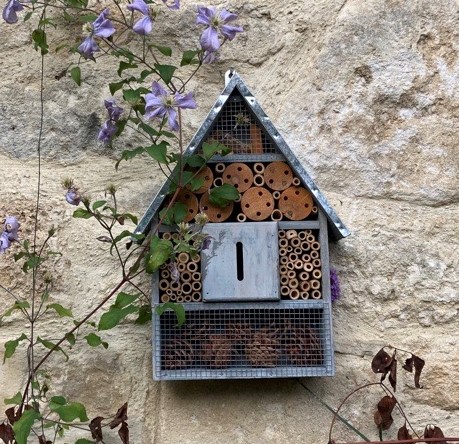To bed! To bed?
Even though it does feel like summer has ended, so far there has been few real traces of autumn, (at least here at Queen’s). It has remained fairly mild, therefore there has still been a good number of flowers on the later flowering species, and, apart from the Fuji Cherry trees in Front Quad, most plants haven’t yet given us much in the way of seasonal colour or started dropping leaves, apart from the Beech tree in the Provost’s Garden.

While we still have good growing conditions there are a few jobs that can be done on the lawns along with the mowing. The lawns at Queen’s are sometimes scarified to remove thatch and moss, both of which curb healthy growth of turf by reducing the amount of water that reaches the soil in dry times and stopping airflow, causing fungal disease. The lawns are also occasionally aerated, either using a garden fork or a machine that punctures the surface like a slitter, helping to deter moss by combating compaction. Both of those activities can cause the turf to look quite messy for a while, until the grass regrows, which is why it’s good to do it in early autumn, to allow the grass time to recover before winter sets in. The recovery can be assisted by top dressing (normally using a sandy mix, to increase drainage) and reseeding any bare patches with grass of a similar type (don’t sow utility grass seed if you have fine turf and vice versa). There is also the option to use fertiliser, which at this time of year would be an autumn feed which strengthens the root system, improving the plant’s resilience.
However, now we will start experiencing ‘Fall’ full on, and the big tidy up will start as we ‘put the garden to bed’.
Clearing fallen leaves is a traditional autumnal task, but recently there has been a lot of discussion about if it’s necessary or desirable. Many invertebrates will overwinter in leaf-litter and provide birds with a food source in the colder months (I am sure many of you will have witnessed a blackbird searching through loose leaves for a morsel of food).
A layer of leaves will also form a natural mulch protecting the soil from erosion, providing insulation for the roots of plants and preventing the water that’s in the soil being lost too quickly by evaporation in dry and windy conditions. Plus, it helps hold back weed growth.
It may look as though there is no reason to collect leaves anymore, but of course in some cases it is still necessary for instance if the leaves fall on paths and are slippery, or on lawns where they can damage the grass by blocking out light and promoting fungal disease. In the latter instance, most leaves are quickly removed by mowing the lawn on a higher cut (don’t do this if there is a frost as walking on frozen grass will damage it, and you will be left with a track of black footprints).
It is also advisable to clear the leaves off the crowns of smaller, weaker plants if they are not tender or dormant and therefore benefiting from or unaffected by the leaves. Last winter I left quite a lot of leaves on the back of the borders (less at front where it can end up on paths and lawns) but started to clear in late winter before the bulbs came up to prevent smaller species like snowdrops being hidden.
Whatever you do, don’t get rid of leaves as it breaks down into fantastic compost.
It will take between one to three years depending on the species of plant, size of leaf, if the leaf has been shredded by a mower or garden vacuum, and whether or not it’s mixed with grass or other greenery. If you are allowed to burn garden waste, and wish to burn dry leaves, just be careful as there may be hedgehogs hibernating in piles of leaves or sticks.
The next biggest task in the garden at this time of year is cutting back, which is really pruning for herbaceous plants and an extreme extension of the deadheading done throughout the year.
Again, there has been a move away from doing this in recent years, prompted by a new garden aesthetic which appreciates the winter structure of plants, plus the rise of eco-friendly gardening.
When deciding if, what, and when to cut back I tend to ask myself these questions:
- Do I like its appearance?
This has three main factors for me. The first being has it ‘gone over’ before the surrounding plants have? If a plant has finished flowering, has uninteresting seed heads and has gone brown while it’s neighbours are still attractive, I will chop it to the base to keep the area looking fresh. And doing this in late summer with the earlier flowering plants can result in the border looking summery for another two or three months if planted with the right species and with frost free conditions. In some plants like Echinops it can even promote new growth and a second flush of flowers sometimes in mild conditions. Second, will the leaves change colour or the seedheads look nice? If the answer to this is yes, I will most likely leave it until it begins to look tatty and then chop, but in the case of grasses that look good all winter that means they will be left to March, when they need to be removed to allow the new shoots to come up. Third, will it look nice with frost or snow on it? Again, keep until the answer is no.

- Does this plant have wildlife value?
If the seeds haven’t dropped from the seedheads they can provide a great food source, for birds in particular, but they also can provide refuge to invertebrates, along with hollow stems i.e. those of Angelica or curled up leaves. Of course, if you don’t like the look of these plants in winter and would rather chop them down you can put out bird food and have a beetle bank or bug hotel for the creepy crawlies.

- Is it ‘practical’ to cut some or all of it down now or sensible to leave some or all of it?
I will sometimes lop something down completely or take a few stems down but leave the rest for practical reasons such as –
Time
If something will take quite a while to do, and that time is unlikely to be available later in the year or in the following year before spring, but there is time now it’s sensible to just get the job out the way.
Safety and access
Consider removing spiky/thorny plant material by paths, or anything narrow sticking out at eye level, as in poorer light conditions it’s more likely that they will cause harm. Also, plants flopping over paths, wet with rain, fog and dew can be an inconvenience to passers-by, soaking clothing, so some stems can be removed or cut partway back to give a clearer passage.
Frost protection
Some tender plants benefit from being left untouched until spring, as their stems provide protection against frost. A case in point is Penstemon, especially the larger flowered cultivars. The foliage of some plants can also protect neighbouring, less hardy plants from the elements, but be careful as it can also flop, especially once frosted or after snowfall and go from insulating blanket to rotting barrier which brings us to the last consideration.
Visibility
Will leaving the old stems and leaves of something hide winter and early spring flowering plants from view, or worse, impede their growth? If you plant for year-round interest, you will likely have to sacrifice the old to appreciate the new.
The end result is that I start cutting things in late August and don’t finish until the following March as I constantly ‘edit’ the borders.
You can put all the cut material on the compost heap, or, if you don’t have a composting area, (or you do but you wish to save time, and you’re not a neat freak) you can use the ‘chop and drop’ method as I do in my home garden, which has the same benefits (and drawbacks) as the natural mulch created by leaving fallen leaves on the borders. Whichever you choose to do, it will break down into compost faster if it is snipped into smaller pieces.
The remaining important task is to bring in the tender plants and replace the ‘summer’ bedding with ‘winter’ bedding. I brought in Pelargoniums and succulents three weeks ago, before the first air frost, just to be on the safe side. They could have safely stayed out as if turns out but, having not got spares, I didn’t wish to risk it. If you have time and space available try to take cuttings of tender plants in late summer as ‘insurance’, then you can push the boundaries and keep summer going for longer. I have replaced the planting in the urns in Back Quad but the Provost’s pots are still going strong so I have left them in place, and will not remove the tender plants until they finish flowering or there is a ground frost forecast, whereupon I will bring those into the greenhouse. I selected perennial plants, that can hopefully be reused next year and will put hardy plants, also perennial, in their place.

Of course, if you are bringing your tender plants into a greenhouse or conservatory, it is sensible to give it a clean and tidy beforehand as it’s easier before it’s crammed to the rafters, and may create a bit more space in the process. Cleaning the glass, if not done over the summer, will help maximise light for the plants, especially if the glasshouse is given extra insulation by attaching bubble wrap inside.
So, as the garden settles down to sleep for a few months, I shall still be busy and every now and then the garden will stir in its slumber to provide us with treats that delight all the more for their relative rarity, making me think that perhaps it’s only lightly snoozing and like us is still active throughout the colder, darker months.
It’s well worth keeping your eyes peeled so you don’t miss all the natural beauty still to come.



